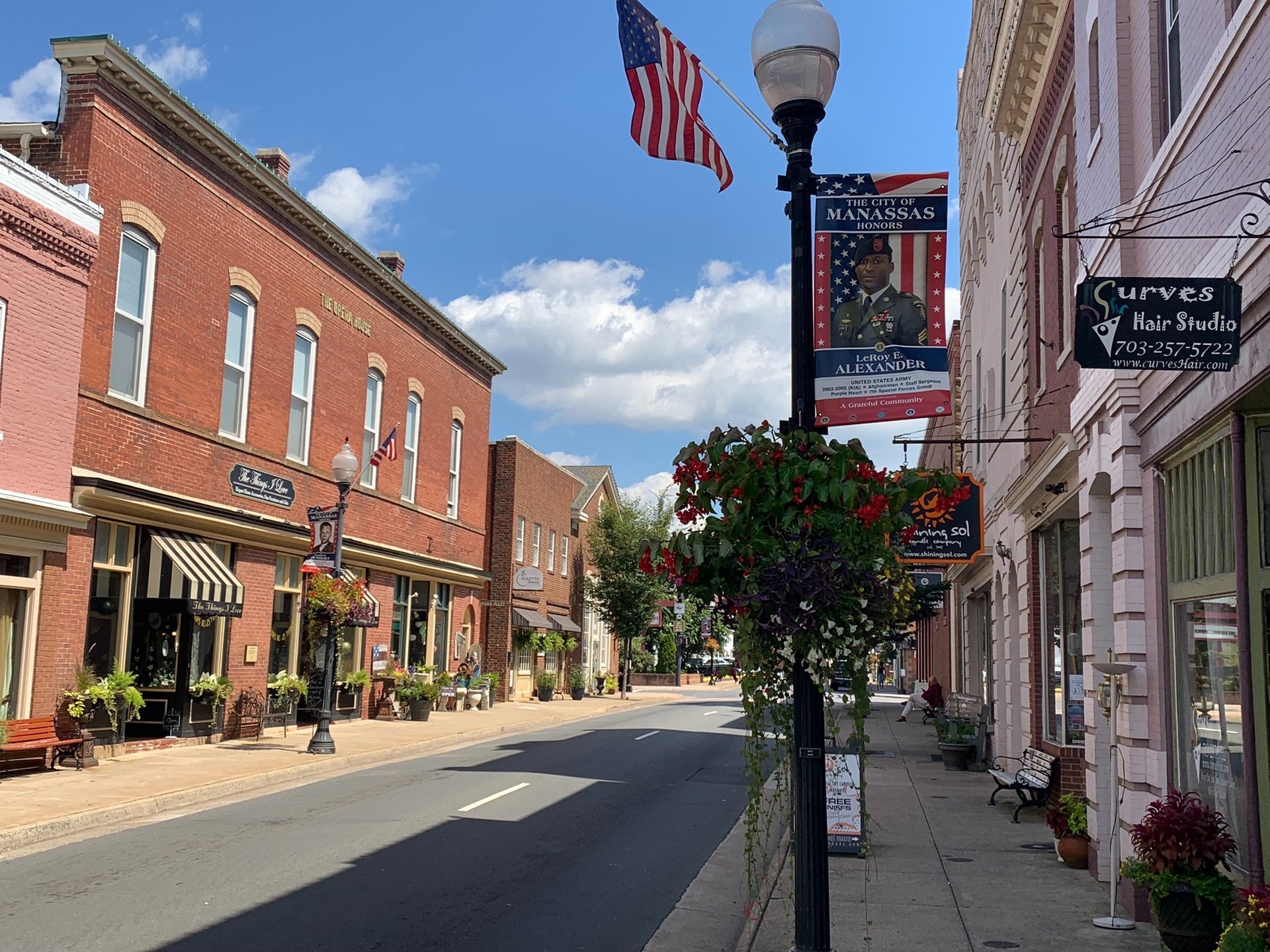
Things To Do in Manassas, Virginia
Historic Manassas Virginia
Manassas was a collection of plantations before the opening shots of the First Battle of Bull (Manassas). Union Brigadier General Irvin McDowell commanded 35,000 troops of the Army of Northeastern Virginia who marched from Washington, D. C. to Centreville along the Alexandria Turnpike to seize Manassas Junction. This was a vital transportation route where the Orange and Alexandria Railroad met the Manassas Gap Railroad leading west to the Shenandoah Valley. If McDowell seized this junction, he would control the best overland approach to the Confederate capital of Richmond. The fate of Manassas was forever changed.
The Union attack on July 21, 1861 at Sudley Springs was originally planned to cross Bull Run at the Stone Bridge. But false rumors lead Union planners to believe the Stone Bridge was readied with explosives for the Union approach. As a result, the Union Army of Northeastern Virginia, the nucleus of the Army of Potomac, moved north to cross Bull Run and attacked the Confederate Army of the Potomac under the command of General P. T. Beauregard. The Union attack swept south across the Warrenton Turnpike and pressed forward to Henry Hill. There the Union attack ran into Virginia’s First Brigade (later known as the Stonewall Brigade). General Thomas Jonathan Jackson stood tall on Henry Hill and with the help of the Third Brigade of the Army of the Shenandoah under General Barnard Elliot Bee of South Carolina, the Union assault turned into a retreat. The Union Army fled east using the Stone Bridge to cross Bull Run and use the Warrenton Turnpike to flee to Centreville, consolidate, and return to Washington.
The original Stone Bridge (c. 1825) remained intact through 1861. On the 9th of March 1862 General Joseph E. Johnston and the Confederate Army of the Potomac left winter camp in Centreville and Manassas. After securing supplies at Manassas Junction, the army rear guard used explosives to destroy the Stone Bridge after anticipating a march south to defend Union advances on Richmond.
Union Army engineers eventually constructed a temporary wooden span across Bull Run using the remaining bridge abutments. This bridge served Union General John Pope’s army at Second Manassas, August 28-30, 1862. After suffering another costly defeat, Union forces used the Warrenton Turnpike bridge as their primary line of retreat. In the early hours of August 31, the bridge was again destroyed, this time by the Union rear guard.
The Manassas National Battlefield Park like the City of Fredericksburg experienced two major battles during the Civil War. The first battle of the Civil War came as Lincoln ordered Union General Irvin McDowell to lead 35,000 troops out of Washington, D.C. to seize the railroad junction at Manassas which connected the Orange & Alexandria Railroad, and the Manassas Gap Railroad which led to the Shenandoah Valley. If General McDowell’s Army of the Potomac could capture Manassas Junction the Confederate forces would be divided and movement of troops and supplies would be disabled between Richmond and Washington. But Confederate General P. T. Beauregard Commander of the Confederate Army of the Potomac was waiting for the Union attack at Bull Run.
On July 21, 1861 a series of movements at Bull Run by Union forces signaled the start of the battle. Previous to this movement General Beauregard recognized the need for additional troops and asked Richmond for help. Confederate General Joseph E. Johnson was commanding the Army of the Shenandoah (11,000 troops) in the Shenandoah Valley to oppose a force of 18,000 Union soldiers of the Army of the Shenandoah commanded by General Robert Patterson. While this Union force occupied the northern parts of the Shenandoah Valley, General Patterson received orders to advance on the smaller Confederate force commanded by Johnson, and keep them from joining General Beauregard at Manassas.
General Johnson was ordered to move his brigades to Manassas to support General Beauregard’s Army. Moving his force toward Winchester, General Johnson was able to outmaneuver Union forces after the Battle of Hoke’s Run (Berkeley County, West Virginia) and load his troops on trains for transport to Manassas Junction. The failure of General Patterson to block General Johnson and keep him from arriving on the Manassas Battlefield in time to join the fight against General McDowell at Bull Run was the difference in victory versus defeat for the Union.
The Second Battle of Manassas occurred after the Union Army of the Potomac under the command of Major General George B. McClellan withdrew from the Peninsula Campaign after the Battle of Seven Pines near Richmond. Major General John Pope was given command of the Army of Virginia and consolidated his three separate corps (40,000 troops) at Culpeper on July 13, 1862 with the goal of capturing Gordonsville and the Orange & Alexandria Railroad.
Concerned that his harvest supply line from the Shenandoah Valley to Richmond would stave his Army, General Lee sent Stonewall Jackson, and later General A. P. Hill to protect the rails from seizure by Pope’s troops moving south from Culpeper. After Jackson learned Pope’s Union Cavalry was observed probing his lines he pressed an attack on August 9th at the Battle of Cedar Mountain (8 miles south of Culpeper). The Confederate divisions of Jackson and Ewell defeated Pope and caused the Union Army of Virginia to retreat north of the Rappahannock River.
Confederate Cavalry Commander J.E.B. Stuart then flanked Pope’s Army and captured hundreds of soldiers, horses, and General Pope’s dispatch book. After General Lee learned of the contents of Pope’s dispatch book, he realized Pope possessed a superior force. General Lee changed his attack plan. Lee ordered the Stonewall Division (23,000 troops) to flank (right) Pope’s Army while Longstreet’s Corps kept the Federals in a defensive position along the Rappahannock River.
On August 24th Stonewall Jackson was ordered to destroy a section of the Orange & Alexandria Railroad to deny a supply line to the Union Army of Virginia. On August 27th Jackson arrived at Manassas Junction to find over a mile of Union supply trains full of food, ammunition, military clothing, first aid materials, equestrian feed & supplies, and hundreds of barrels of whiskey, brandy, & wine which General Jackson ordered destroyed. Jackson’s troops carried off as much as they could from the Union supply depot and burned the remaining supplies.
When General Pope learned of the raid of the supply train he believed Jackson’s force could not be reinforced and he was determined to find Jackson and attack the divided Confederate Army. Jackson’s force marched from Manassas Junction to Groveton (next to the battlefield of First Manassas) and used an unfinished railroad cut as a defensive position until he could be reinforced by Longstreet and Lee. On August 28th Jackson attacked a column of General John Gibbons Brigade marching on the Warrenton Turnpike, and the Battle of Second Manassas had begun. Jackson’s actions were planned to draw Pope into committing the bulk of his Army into battle knowing the arrival of Longstreet’s Corps would lead to a decisive victory.
On Aug 29th General Pope was convinced he had trapped Jackson’s troops who were now stretched for 3,000 yards between Groveton on the Warrenton Turnpike to Sudley Springs on Bull Run. Pope launched a series of uncoordinated attacks against the trenched Confederates. There were several temporary penetrations of the Confederate positions but poor coordination, confusing orders, and battlefield execution by General Pope allowed Jackson’s men to beat back these attacks with heavy casualties on both sides.
On August 29th at 8:15 a. m. Union Cavalry Commander General John Buford reported to General McDowell (supporting the Army of Virginia after the Peninsula Campaign) of Longstreet’s 25,000 troops arriving at Gainesville. McDowell held the information until 7:00 p. m. McDowell also refused to move two full and ready corps of the Army of the Potomac from Alexandria to Manassas to support Pope during Second Manassas. His lack of cooperation was a political tactic to have General Pope removed from command, and reinstated to control all Union armies. His actions were later proven to be a court-martial offense although it was never addressed as such by President Lincoln.
After General Pope realized Longstreet’s Corps was on the battlefield he mistakenly believed the arrival of Longstreet was to provide support to Jackson for a withdrawal of the Confederate Army. Instead, Longstreet reinforced and extended Jackson’s Line across the Warrenton Turnpike past Chinn Ridge to Bald Hill. On August 30th Pope mistakenly interpreted enemy movement as a retreat and ordered an attack. Confederate artillery repulsed the Federal attack, and Lee and Longstreet took advantage of disorganized enemy forces after the failed attack by launching a massive counterattack on the Union left. After initial success Pope’s Army was able to neutralize the attack at Chinn Ridge long enough for Pope to consolidate his forces on Henry Hill where a rear guard was formed, and the Army of Virginia could retreat from the battlefield in an orderly fashion.
– Dwayne Moyers
The Union attack on July 21, 1861 at Sudley Springs was originally planned to cross Bull Run at the Stone Bridge. But false rumors lead Union planners to believe the Stone Bridge was readied with explosives for the Union approach. As a result, the Union Army of Northeastern Virginia, the nucleus of the Army of Potomac, moved north to cross Bull Run and attacked the Confederate Army of the Potomac under the command of General P. T. Beauregard. The Union attack swept south across the Warrenton Turnpike and pressed forward to Henry Hill. There the Union attack ran into Virginia’s First Brigade (later known as the Stonewall Brigade). General Thomas Jonathan Jackson stood tall on Henry Hill and with the help of the Third Brigade of the Army of the Shenandoah under General Barnard Elliot Bee of South Carolina, the Union assault turned into a retreat. The Union Army fled east using the Stone Bridge to cross Bull Run and use the Warrenton Turnpike to flee to Centreville, consolidate, and return to Washington.
The original Stone Bridge (c. 1825) remained intact through 1861. On the 9th of March 1862 General Joseph E. Johnston and the Confederate Army of the Potomac left winter camp in Centreville and Manassas. After securing supplies at Manassas Junction, the army rear guard used explosives to destroy the Stone Bridge after anticipating a march south to defend Union advances on Richmond.
Union Army engineers eventually constructed a temporary wooden span across Bull Run using the remaining bridge abutments. This bridge served Union General John Pope’s army at Second Manassas, August 28-30, 1862. After suffering another costly defeat, Union forces used the Warrenton Turnpike bridge as their primary line of retreat. In the early hours of August 31, the bridge was again destroyed, this time by the Union rear guard.
Manassas Area Picture Albums
Bristow, Gainesville, Haymarket Aden, Brentsville, Bristow Station Battlefield Heritage Park, historical highway markers, Nokesville, Prince William County interpretive markers, residential subdivisions, and Virginia Civil War Trails interpretive markers.
Manassas National Battlefield Park Blackburn’s Ford, Brawner Farm, Buck Hill, Chinn Ridge, Conner House, Groveton Cemetery, Hazel Plain, Henry Hill, Hillwood Mansion, Matthews Hill, Signal Hill, Stone House, Sudley Springs, Thornberry House
Manassas, Virginia Residential subdivisions, historical markers, government buildings, retail stores, historic buildings, and church buildings, George Mason University Science and Technology Campus, historical makers of the Manassas Industrial School (Jennie Dean Memorial), City of Manassas historic district, Manassas National Battlefield Park, and Prince William County.
Main Phone
Email Address
540-446-6284
Connect
Explore
Site Map
About Us
Dwayne Moyers is a trusted real estate professional with extensive experience in buying and selling homes across Fredericksburg, Stafford, Spotsylvania, and surrounding areas. Proudly affiliated with Serhant., Dwayne combines local market knowledge with a commitment to delivering exceptional service tailored to your unique needs.
Contact Dwayne
Email: moyersteam@gmail.com
Phone: (540) 446-6284
Services
Address
1660 International Dr. Suite #600, Mclean Va, 22102






Resources













